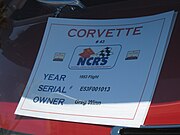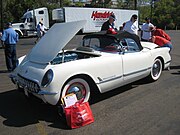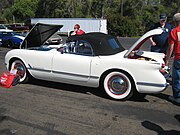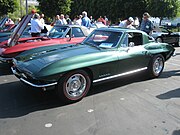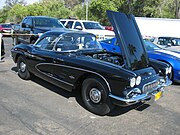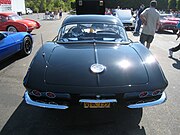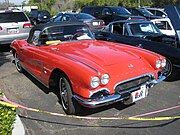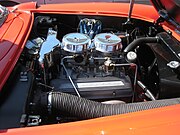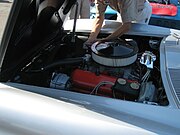Talk:Chevrolet Corvette
| This is the talk page for discussing improvements to the Chevrolet Corvette article. This is not a forum for general discussion of the article's subject. |
Article policies
|
| Find sources: Google (books · news · scholar · free images · WP refs) · FENS · JSTOR · TWL |
| Archives: 1 |
| Chevrolet Corvette is a former featured article candidate. Please view the links under Article milestones below to see why the nomination was archived. For older candidates, please check the archive. | ||||||||||||||||
| ||||||||||||||||
| Current status: Former featured article candidate | ||||||||||||||||
| This article is of interest to the following WikiProjects: | ||||||||||||||||||||||||||||||||||||||||||||||||||
Please add the quality rating to the {{WikiProject banner shell}} template instead of this project banner. See WP:PIQA for details.
Please add the quality rating to the {{WikiProject banner shell}} template instead of this project banner. See WP:PIQA for details.
| ||||||||||||||||||||||||||||||||||||||||||||||||||
Why
Why do the C1, C2, C3, get one paragraph each, and the C4, C5, and C6 get several sections? Just because they're newer The old cars are just as, if not more important. The C4, C5 and C6 sections need to be condensed... they have their own articles. 129.74.221.209 (talk) —Preceding undated comment added 07:51, 12 October 2009 (UTC).
- Older generation sections will be expanded with more text and sub-sections with limited editions, etc.(Vegavairbob (talk) 11:38, 16 December 2009 (UTC))
Why are owner demographics mentioned? 207.210.29.71 (talk) 15:38, 24 August 2009 (UTC)
Added sales data
I readded sales data removed by User:CZmarlin and added 3 years to it. Tunishao (talk) 17:44, 30 October 2009 (UTC) Oh and you can't move them to each generation since obviously sales for a single year can overlap two generations. Tunishao (talk) 17:49, 30 October 2009 (UTC)
Engines in the main infobox
I think listing every engine and transmission that was ever available on the car during its 50 years in the main infobox is not very useful to the reader. The changes in engine options and technology should be detailed within each of the generation articles. It has been many years that you could get a six-cylinder Corvette with a two-speed transmission! — CZmarlin (talk) 16:38, 16 December 2009 (UTC)
- Ok...long engine list deleted from infobox (engine charts in generation articles good enough) (Vegavairbob (talk) 07:28, 18 December 2009 (UTC))
Generation sections
Vegavairbob and anyone else with time to edit: long ago, the goal was to make the section for each generation a summary which invited people click for more information (where it would take you to the C6 page, for example). We never quite achieved that though because the information in each section was not cleaned-up / reduced after the generation pages were forked. Long story short, it sure would be nice if each section could be turned into the summary and the vast majority of the detailed dropped into the sub-pages. —Mrand Talk • C 00:25, 18 December 2009 (UTC)
- Sounds good to me. There is duplication between main article and generation articles. There are large sections on Z06 in C5 & C6 I guess they have to be moved to generation articles except for a small paragraph on that model for main article? I now have seven windows going in my computer to transfer large sections from main article to generation articles. will summarize larger sections removed in main article. What about full production notes section in main article... Should that stay? This is all six charts made into one from all generation articles.(Vegavairbob (talk) 03:46, 18 December 2009 (UTC))
- Large sections on special models transferred to generation articles. small summaries of all sections transferred retained for main article. Further editing will follow on main article. Will complete editing on the transferred text to the generation articles over a two day period to edit them with the existing text. Best versions will be selected for any duplicated text. Info box simplified as well. Production notes retained...advise. (Vegavairbob (talk) 07:16, 18 December 2009 (UTC))
- Looking much better already - Keep up the good work! My first reaction is that the production notes are a nice to have summary across the years - but I'm guessing it will end up overwhelming the article once the C3-C6 sections get trimmed down some more, and so the chart will need to be broken up into the various generation articles. Any other opinions? —Mrand Talk • C 15:58, 18 December 2009 (UTC)
- The notes are in the generation articles. I added the complete one from the gen articles.I think it should stay, but not sure. What do you think? It looks good and it is after a summary.(Vegavairbob (talk) 17:54, 18 December 2009 (UTC))
- Sounds good to me. There is duplication between main article and generation articles. There are large sections on Z06 in C5 & C6 I guess they have to be moved to generation articles except for a small paragraph on that model for main article? I now have seven windows going in my computer to transfer large sections from main article to generation articles. will summarize larger sections removed in main article. What about full production notes section in main article... Should that stay? This is all six charts made into one from all generation articles.(Vegavairbob (talk) 03:46, 18 December 2009 (UTC))
Model years vs Calendar years
The fuel injection article had "In 1957 the Chevrolet Corvette had this fuel injected engine as an option" and was recently changed to "General Motor's fuel injected engine was optional in the 1957 Chevrolet Corvette". The phrase "in 1957" usually means the 1957 calendar year (at least it does to a non American reading a article not specific to American cars. But I know that "the 1957 Corvette" always means mid 1956 to mid 1957 to an American and usually mid 1957 to mid 1958 to a non-American. So I have two problems. One is that I have no idea if the fuelie engine was introduced in the 1956 or 1957 calendar year. The other is that the Corvette article itself does not make it clear whether it is using calendar years or US specific model years. Stepho (talk) 00:29, 27 December 2009 (UTC)
- 1957 means model year in America-Sept 56-Aug 57. 1956-1957 section refers to 1956 and 1957 cars-simple(Vegavairbob (talk) 06:08, 27 December 2009 (UTC))
- Thank you for your answer but the answer is not so simple. The mere fact that I had to ask the question shows that there is ambiguity. Others will have the same problem as me. As I said in my original question, somebody has copied '1957 Corvette' into a non American article without realising they were dealing in model years. That article deals in calendar years and now says the fuelie engine was introduced in the 1957 calendar year when it was really introduced in the 1956 calendar year (1957 model year). I can correct the fuel injection article to 1956 but perhaps a note somewhere saying that this article deals in US model years is in order. Stepho (talk) 08:34, 27 December 2009 (UTC)
- I would encourage you to not say just "1956 calendar year", because that would likely increase, not decrease the confusion. If you wanted to be perfectly clear, perhaps you are looking for wording something like "Introduced in the 1957 model year cars". If you don't think that is enough, perhaps "introduced in 1956 on the 1957 model year", although that is a bit awkward. —Mrand Talk • C 15:41, 28 December 2009 (UTC)
- I've stirred up a hornets nest. There's more discussion at WikiProject Autos discussion page. Stepho (talk) 22:44, 28 December 2009 (UTC)
- Hmmm... I don't see much of a hornets nest. An early consensus seems pretty clear: use model year, and make it clear that model year is being used. Anything more or less than that and it creates unnecessary confusion. —Mrand Talk • C 01:46, 29 December 2009 (UTC)
- American cars are referred to in model years, not calender years. so a 1957 Corvette produced from Sept. '56-Aug '57 (regardless of production date) is referred to as a 1957. In the Chevrolet Corvette article, in the C1 section the beginning sentence states: "The first generation Corvette was introduced late in the 1953 model year and ended in 1962." Also, the lead sections of all the Corvette generation articles (C1-C6) were recently written by me using each generation's introduction by its model year..This sentence is in lead section for Chevrolet Corvette C2 "The C2 was produced for the 1963 through 1967 model years." It's clear and stated at the beginning of all Corvette articles...the car is referred to in model years, not calender years. Vegavairbob (talk) 02:34, 29 December 2009 (UTC))
- Hmmm... I don't see much of a hornets nest. An early consensus seems pretty clear: use model year, and make it clear that model year is being used. Anything more or less than that and it creates unnecessary confusion. —Mrand Talk • C 01:46, 29 December 2009 (UTC)
- I've stirred up a hornets nest. There's more discussion at WikiProject Autos discussion page. Stepho (talk) 22:44, 28 December 2009 (UTC)
Only "True sports car"
I have removed what appears to be a 22-year-old statement to calling the Corvette "America's only true sports car", attributed to "Consumer Reports-1978". I believe that the statement is outdated and therefore unneeded; the Viper is obviously a sport car. But I welcome other thoughts. If the consensus is that the mention should remain, I feel very strongly that it should be added as a proper quote, not as a overwhelming blanket statement that most people would argue is untrue. Not to mention, wikipedia articles should be as timeless as possible, and making such statements are the antithesis of that concept. —Mrand Talk • C 15:57, 11 February 2010 (UTC)
- I revised closing lead statements in Chevrolet Corvette from a 2003 reference.(Vegavairbob (talk) 16:41, 11 February 2010 (UTC))
Shouldn't this article cover how many seats this car has?
--Bsoo (talk) 08:46, 10 May 2010 (UTC)
- You are right. I added 'two-seater' to the intro. Stepho (talk) 10:14, 10 May 2010 (UTC)
- If you click on "sports car", you'll find it is defined as "two-seater," so putting the two together is technically redundant... but if someone is asking, there is probably others wondering that, so I'm not going to revert it. —Mrand Talk • C 02:08, 11 May 2010 (UTC)
- Some sports cars had 3 or 4 seats (see Sports car#Seating, eg McLaren F1 had 3 seats). Also, some people consider (rightly or wrongly) some two-door, four-seat cars to be sports cars (eg Mustang or Celica). Stepho (talk) 02:32, 11 May 2010 (UTC)
Mustang, Camaro or Celica are sporty cars. — Preceding unsigned comment added by SirVette (talk • contribs) 15:04, 27 November 2011 (UTC)
Fibreglass Body
One of the unique features of the corvette since inception was it's fibreglass body. It has many benefits such as weight and, here in Canada, no rust. I don't see it mentioned in the article and thought that it should have some prominence. Thanks for reading. --RRSPS (talk) 07:41, 10 August 2010 (UTC)
- Agree. It should be mentioned. It's lazy and poor article for not mentioning it. --76.92.113.139 (talk) 06:20, 26 March 2013 (UTC)
- The Corvette is not predominantly known as a "fiberglass car" and it should not be mentioned as such in the lead. It may have had a fiberglass body, but it was not marketed or known or referred to as a fiberglass car. To quote an executive chief engineer "Corvette has never been focused on an exclusive material – be it aluminum, carbon fiber, or fiberglass. Instead, we are constantly looking for the best materials structure, powertrain, and chassis to improve the performance of Corvette." Over the years, the content of fiberglass has dropped in favor of plastic and carbon fiber materials. -- Mufka (u) (t) (c) 21:55, 27 March 2013 (UTC)
- Mr Mufka you have reverted my edits. Please stop. Corvettes have ALWAYS been known as fiberglass bodied cars and you are censoring to the point it makes me wonder about bias. Do not delete 'information' --76.92.113.139 (talk) 22:07, 27 March 2013 (UTC)
- You haven't addressed my statement above. -- Mufka (u) (t) (c) 22:23, 27 March 2013 (UTC)
- I have sourced at end of this page. Every corvette history book Mr Mufka says it was a fiberglass car. If you have an issue with that then explain it. Modern corvettes are made of nonfiberglass materials but that doesn't cover it's timeline. — Preceding unsigned comment added by 76.92.113.139 (talk) 22:56, 27 March 2013 (UTC)
- Show me any reference to a Corvette that starts out with "The Corvette, a fiberglass car...". I don't argue that a mention of fiberglass is appropriate, but it doesn't appear that you are taking a thoughtful approach to how you're adding it. Since the discussion is ongoing, I ask that you revert your fiberglass additions in a show of good faith until we can reach consensus on this topic. -- Mufka (u) (t) (c) 00:50, 28 March 2013 (UTC)
- I would like a paragraph on when the years this car was fiberglass and when they transition to steel,aluminum or composites. Thats why i searched this article and was disappointed. Go ahead and remove the references but i'm hoping for a paragraph on this.--76.92.113.139 (talk) 02:26, 28 March 2013 (UTC)
- The use of fiberglass is covered in each of the relevant sub articles on the different generations. Maybe we can borrow from the C1 article and use "The outer body was made out of then-revolutionary fiberglass material, selected in part because quotas, left over from the war, limited the availability of steel." -- Mufka (u) (t) (c) 09:40, 28 March 2013 (UTC)
- I would like a paragraph on when the years this car was fiberglass and when they transition to steel,aluminum or composites. Thats why i searched this article and was disappointed. Go ahead and remove the references but i'm hoping for a paragraph on this.--76.92.113.139 (talk) 02:26, 28 March 2013 (UTC)
- Show me any reference to a Corvette that starts out with "The Corvette, a fiberglass car...". I don't argue that a mention of fiberglass is appropriate, but it doesn't appear that you are taking a thoughtful approach to how you're adding it. Since the discussion is ongoing, I ask that you revert your fiberglass additions in a show of good faith until we can reach consensus on this topic. -- Mufka (u) (t) (c) 00:50, 28 March 2013 (UTC)
- I have sourced at end of this page. Every corvette history book Mr Mufka says it was a fiberglass car. If you have an issue with that then explain it. Modern corvettes are made of nonfiberglass materials but that doesn't cover it's timeline. — Preceding unsigned comment added by 76.92.113.139 (talk) 22:56, 27 March 2013 (UTC)
- You haven't addressed my statement above. -- Mufka (u) (t) (c) 22:23, 27 March 2013 (UTC)
- Mr Mufka you have reverted my edits. Please stop. Corvettes have ALWAYS been known as fiberglass bodied cars and you are censoring to the point it makes me wonder about bias. Do not delete 'information' --76.92.113.139 (talk) 22:07, 27 March 2013 (UTC)
"continuously-manufactured"?
Is it correct to call the Corvette "the first and only continuously-manufactured American sports car"? I believe only a small handful of production prototypes were produced in 1983 (this could be seen as a break in manufacturing), and there were certainly sports cars that came before the Corvette. I believe just about any Duesenberg coupe could be aptly described as a "sports car", as could many Mercers, V12 and V16 Cadillac coupes, etc. Mike Helms (talk) 13:03, 18 January 2011 (UTC)
- On second thought, I think my objection is more with the confusion between the 50th anniversary and its continuous production. The way the wording was before, it sounded like the Corvette celebrated the 50th anniversary of being the ONLY continuously produced American sports car. It's not; it's just the first (and currently the only) American sports car to be continuously produced for 50 years (despite the whole question about whether 1983 was a production year, which is really a sideshow discussion and not relevant). And the word "true" is entirely subjective, and not appropriate here. Nobody doubts that the Corvette is a sports car. Mike Helms (talk) 19:33, 3 February 2011 (UTC)
Duntov
The way the text is written in the History section, Zora Arkus-Duntov's introduction into the article was rather poorly written. There is no previous mention of Arkus-Duntov in the article, nor is there any description of who he is to GM, Chevrolet and specifically the Corvette. His name is just unceremoniously plopped in midway through this section with no point of reference or backstory. Monoblocks (talk) 03:04, 22 January 2011 (UTC)
Corvette redirect
I have started a discussion at Talk:Corvette#Requested move about redirecting Corvette to this article, in case anyone here would like to participate. Theoldsparkle (talk) 16:10, 26 April 2011 (UTC)
- The proposal has been re-listed, so there is still time to participate in the discussion if you have not already. --Born2cycle (talk) 18:43, 4 May 2011 (UTC)
Prices. Why?
WP:NOPRICES is pretty clear, so why does this article (and the sub-articles for each generation) have the MSRP for every model / model year? --Biker Biker (talk) 17:13, 26 August 2011 (UTC)
- OK, so given that no reason has been offered in the past three weeks I will start to delete the prices. --Biker Biker (talk) 16:51, 19 September 2011 (UTC)
Racing
Shouldn't there be something about the Corvette GTP IMSA car, as well as the upcoming Daytona prototype under the racing section? SchellZ (talk) 01:04, 11 December 2011 (UTC)
pictures
I have uploaded a few pictures of corvettes. If you can recognize the model name and year, feel free to add info to them. The 1953 model was particularly unique because it was Corvette #13 ever rolled off the production line.
-
1953 Corvette convertible #13
-
Blue Flame engine of a 1953 Corvette convertible
-
other side of the Blue Flame engine of a 1953 Corvette convertible
-
1953 Corvette convertible
-
1953 Corvette convertible
-
1953 Corvette convertible
-
1953 Corvette convertible
-
1953 Corvette convertible
-
1962 Corvette soft top convertible
-
1962 Corvette Convertible with removable hardtop
-
1967 Corvette Coupe
-
1967 Corvette Coupe
-
1961 Corvette Convertible with removable hardtop
-
1961 Corvette Convertible with removable hardtop
-
1965 Corvette Convertible
-
1991 Corvette Targa
-
1961 Corvette Convertible
-
1957 Corvette Convertible with removable hardtop
-
1956 Corvette Convertible
-
1956 Corvette engine
-
1965 Corvette 396 ci engine
-
1994 Corvette in rare Copper Metallic
-
1994 Corvette in rare Copper Metallic
Stingray concept car in Transformers
- The new Stingray concept appears in the movie Transformers: Revenge of the Fallen, as the vehicle mode of the character Sideswipe and as Autobot Smokescreen in Transformers Prime
The vehicle mode of Smokescreen on Transformers: Prime might be based on the Stingray concept, but it's most likely not a perfect match, just like Bumblebee's alternate mode is a fictional "Urbana 500". The Stingray does, however, appear in the 2011 movie Transformers: Dark of the Moon, again as Sideswipe, but this time as a convertible.--77.181.102.61 (talk) 00:06, 19 September 2012 (UTC)
WOW....Thanks for that!
Re: Upcoming C7: "A twin-turbo V6 engine may or may not be available as an option" — Preceding unsigned comment added by 98.215.56.3 (talk) 03:53, 8 November 2012 (UTC)
2014 Corvette Engine Size
Everything I have read points to the 2014 Corvette engine being the same 6.2 liter size. Not a smaller engine like the current article suggests. And the V6 option is not true. Merigar (talk) 20:57, 9 November 2012 (UTC)
- Could you please copy and paste the sentences for both of the incorrect statements? -- Cheers, Riley Huntley 21:51, 9 November 2012 (UTC)
I got a nice pic added for the C7. such a beautiful car..
Corvette's a grand tourer.
I found out that it is because it looks like one. 70.135.105.35 (talk) 00:43, 9 February 2013 (UTC)
Article sounds like Propaganda
The biased editors here are now removing all mention of fiberglass. Why? Not one mention of FIBERGLASS body in this terrible article. Here's one source. http://books.google.com/books?id=JWB_6d92sv0C&pg=PA13&dq=corvette++history++fiberglass&hl=en&sa=X&ei=6GtTUenyCaKW2QXFx4CYBQ&ved=0CEUQ6AEwAg#v=onepage&q=corvette%20%20history%20%20fiberglass&f=false --76.92.113.139 (talk) 22:04, 27 March 2013 (UTC)
1962 Corvette Maximum Power
In the 1962 Corvette section, I am having a tug-of-war with someone over the maximum power rating for the 1962 Corvette. It is common knowledge among Corvette historians that the newly introduced 327 cubic inch engine had power ratings of 250 horsepower, 300 hp and 340 hp with a carburetor induction system and 360 hp with fuel injection. This is verified in all of Mike Antonick's Corvette Black Books [1] and many other of the 50 or so Corvette books in my library. Also, typing "1962 Corvette Code 582" into a search engine will produce about 5,000,000 more references. The other editor is quoting a general Chevrolet book that is clearly wrong on this point. I have corrected the 340 number to 360 horsepower. This also brings it into agreement with the Corvette C1 Main Article. Stardust1939 (talk) 20:50, 6 April 2013 (UTC)
NPOV dispute-seventh generation C7
The second paragraph of this section digresses from discussing the car and instead focuses on the car's owner demographics. The section author seems to be trying to express his point of view of the corvette as an "old man's toy". If that wasn't the POV that the author intended to express, this paragraph should be under the "Owner demographics" section and it should use more neutral language.
- the phrase in question addresses the impetus for Chevrolet designers and marketing for the 7th generation in particular. It is part of the gestalt behind the generational re-design. It is not POV, it is a direct quote from a GM executive intimately involved in the design and marketing of the 7th generation. The owners demographic section is more general, reflecting ownership across all generations and models.
- Perhaps, after the first year's sales are known, and more importantly, the demographics of the buyers of the 7th generation model are known, the section can be updated with the information about how successful (or unsuccessful) GM was in changing the demographic skewing of ownership.
If it is a quote, a citation would greatly help improve the neutrality of the tone.
- ^ Corvette Black Book 1953-2005 by Mike Antonick
- B-Class Automobile articles
- High-importance Automobile articles
- Unassessed Sports Car Racing articles
- WikiProject Sports Car Racing articles
- B-Class United States articles
- Low-importance United States articles
- B-Class United States articles of Low-importance
- WikiProject United States articles
- Unassessed Brands articles
- Unknown-importance Brands articles
- WikiProject Brands articles





